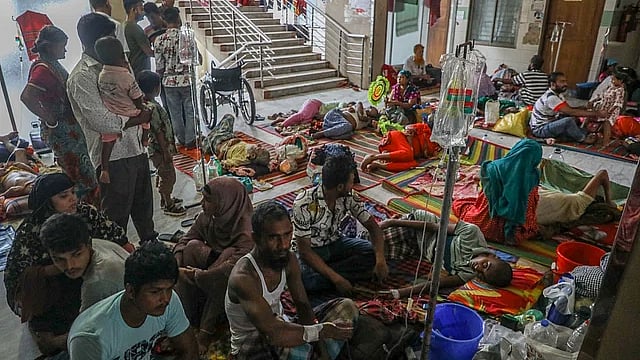Dengue: 41pc of deaths recorded outside of patients’ own districts

A total of six people died of dengue this year so far at the Khulna Medical College Hospital (KMCH). Five of them are from outside of the district Sadar. Only one of them was from Khulna city.
Suhash Ranjan Haldar, residential medical officer of KMCH, confirmed this to Prothom Alo on Tuesday.
He said, “I have to check whether these five patients were from outside the districts. However, apart from different upazilas of the district, patients from different districts are also getting admitted to the hospital.”
Some 41 per cent of the patients, who died of dengue this year, passed away outside of their own districts. The rest died in their own districts.
The physicians and public health experts are concerned with such a high number of dengue related casualties outside the deceased’s own district. They have mentioned several reasons behind this. Firstly, people don’t have trust in the local medical facilities. Secondly, the medical infrastructures outside the big cities, like Dhaka, are not up to the mark yet. Thirdly, when dengue patients move outside their own district, it increases risks and expedites their death.
The World Health Organization (WHO) sat with different directorates of the government to discuss the dengue situation on 21 July. Several issues, including the dengue situation, dengue related casualties, its treatment and public and private initiatives to curb the mosquito-borne disease came up in the discussion.
The WHO delegates highlighted the locations of dengue related deaths. According to their observation, as of 19 August, some 41 per cent of the deceased died outside their own district. And 59 per cent of the people, who died of dengue, breathed their last in their own districts.
Speaking to Prothom Alo, Be-Nazir Ahmed, former director of the Disease Control unit under the Directorate General of Health Services, said that in many cases, patients do not get beds at the hospital. Bearing the additional expenses for treatment is hard for them. Therefore, they move from one hospital to another which may expedite the death of the patients.
Referring to insufficient medical facilities outside Dhaka, he also mentioned the lack of ICU facilities at the government hospitals across the country.
Nazmul Islam, director of the Disease Control unit of the DGHS, does not completely accept the issues raised by the public health experts regarding lack of trust in local hospitals and lack of medical facilities outside Dhaka. He said, “Lack of trust in hospitals is very common in every country. It wasn’t created overnight here.”
The WHO report did not provide any details data about patients from one district died in another one. However, the report showed the movement of patients from one place to another using a map of the country. It has been learned from the report that the highest number of patients are coming to Dhaka.
People from all across the country, except a few areas in Sylhet, are coming to Dhaka. Chattogram is right after Dhaka in this list of cities where patients were moving to take treatment. Apart from different upazilas within the district, patients from Feni, Lakshmipur and three districts of Chattogram Hill Tracts are coming there. Barishal is in the third place in the list of most patients taking admission at hospitals from outside the district. A number of patients from different districts have gone there for treatment.
There is a connection between the number of patients going to a specific district and the casualties recorded there. For instance, the highest number of patients is going to Dhaka and the dengue related casualties is also highest there. Chattogram and Barishal is in the second and third place respectively in the list of highest casualties.
The Mugda Hospital recorded the highest number of deaths among the hospitals in Dhaka. Some 98 patients died there so far. The Dhaka Medical College is second in the list with 90 dengue related deaths. Fifty seven people died of the mosquito-borne disease in Chattogram division, the highest outside Dhaka. And, 34 dengue patients died in the Chattogram Medical College Hospital as of Wednesday.
Chattogram division is followed by the Barishal division in terms of dengue related casualties. Some 37 people died of dengue there. Of them, 25 deaths have been recorded at the Sher-e-Bangla medical college hospital alone.
Md Maniruzzaman, assistant director (administration), of the hospital told Prothom Alo, “A total of 25 patients have died in our hospital so far. We haven’t accumulated the information as to where they came from as yet. However, many of them came in critical condition where we had nothing to do.”
The physicians feel that it is natural that people will come to big hospitals for treatment. However, they believe there should be local medical arrangements to ensure treatments for the patients until the situation becomes critical.
If there are such medical arrangements locally, then it is possible to curb the dengue related casualties, said Mushtaq Hossain, advisor of the Institute of Epidemiology, Disease Control and Research (IEDCR).
He said the fact that 40 per cent of dengue related deaths, recorded outside the patients’ home districts, is unexpected. Besides, there should be monitoring as to whether the guideline for dengue treatment is being followed at local levels or not.
7 more died of Dengue
Meanwhile, seven more people – five in Dhaka and two in other districts – died of dengue in the 24 hours until 8:00 am on Wednesday, taking the death toll this year to 576. Of them, 325 died in August alone.
Besides, 2,367 more people have been admitted to hospitals with the mosquito-borne viral fever during the period, according to the Directorate General of Health Services (DGHS).
*This report appeared on the print and online versions of Prothom Alo and has been rewritten in English by Ashish Basu